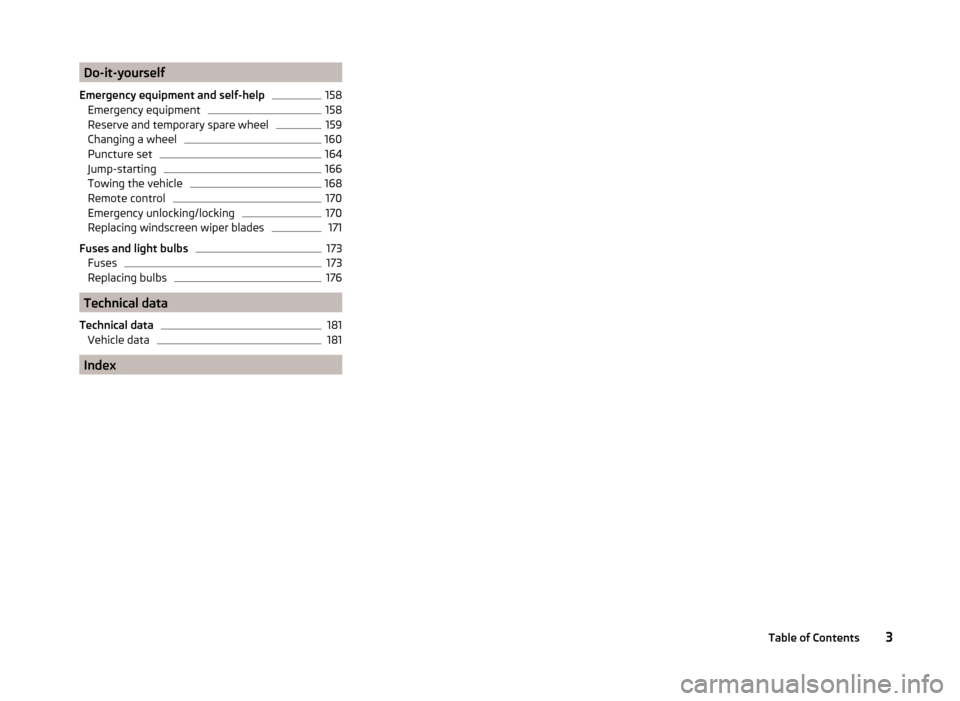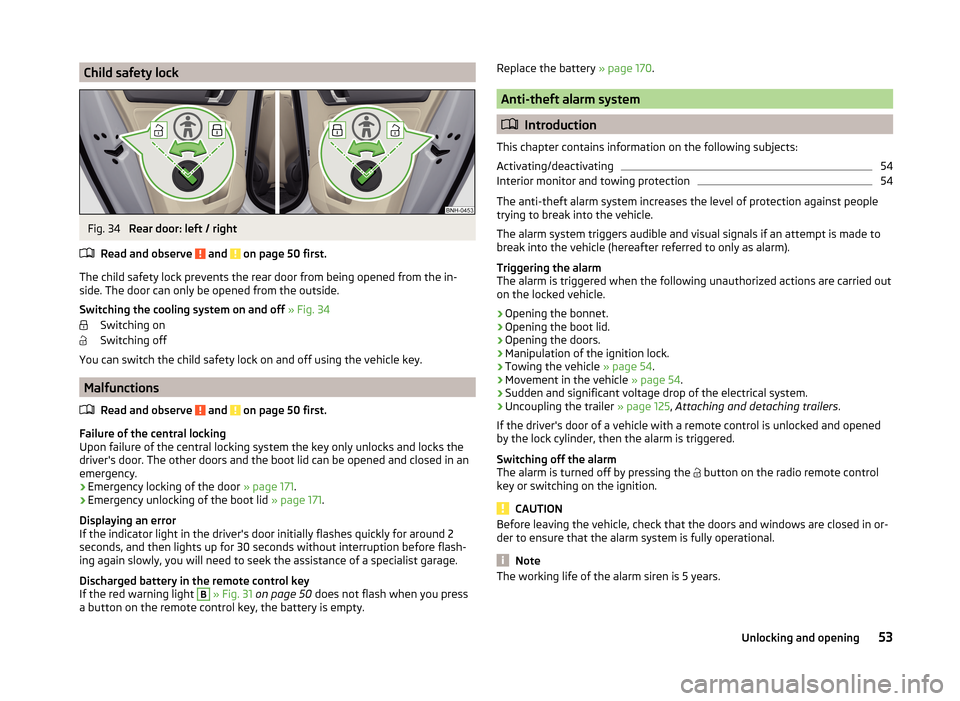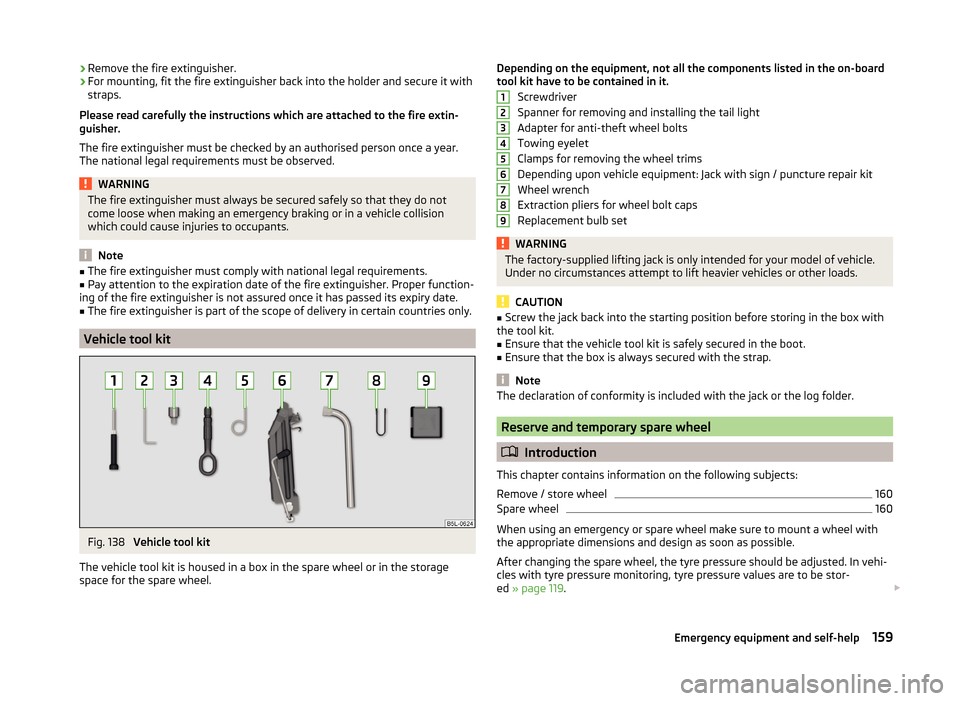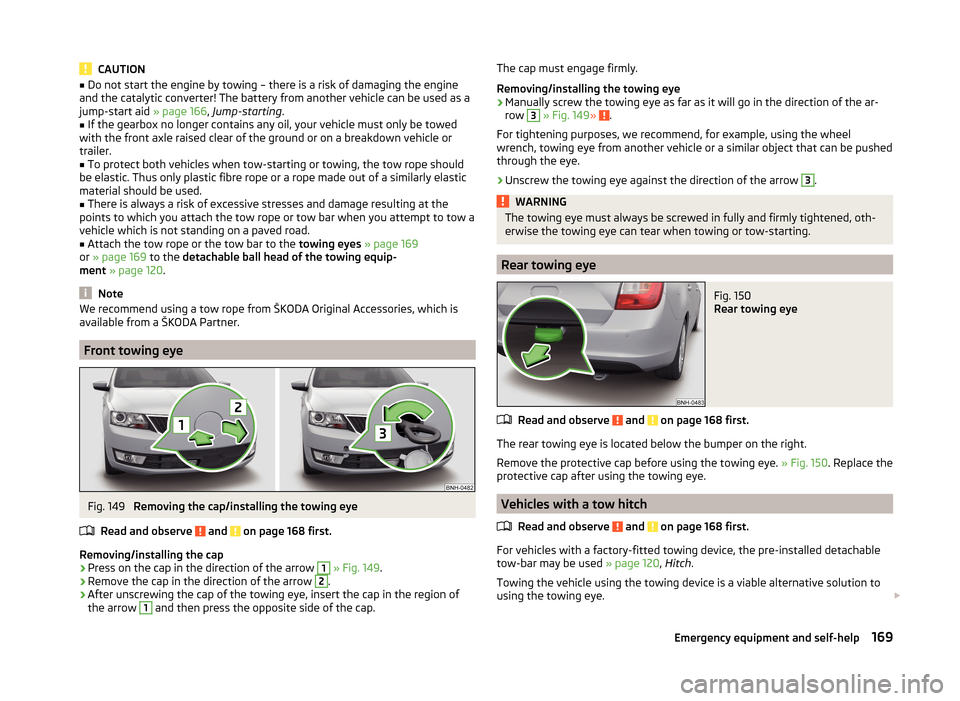emergency towing SKODA RAPID SPACEBACK 2014 1.G Owner's Manual
[x] Cancel search | Manufacturer: SKODA, Model Year: 2014, Model line: RAPID SPACEBACK, Model: SKODA RAPID SPACEBACK 2014 1.GPages: 204, PDF Size: 27.11 MB
Page 6 of 204

Do-it-yourself
Emergency equipment and self-help158
Emergency equipment
158
Reserve and temporary spare wheel
159
Changing a wheel
160
Puncture set
164
Jump-starting
166
Towing the vehicle
168
Remote control
170
Emergency unlocking/locking
170
Replacing windscreen wiper blades
171
Fuses and light bulbs
173
Fuses
173
Replacing bulbs
176
Technical data
Technical data
181
Vehicle data
181
Index
3Table of Contents
Page 56 of 204

Child safety lockFig. 34
Rear door: left / right
Read and observe
and on page 50 first.
The child safety lock prevents the rear door from being opened from the in- side. The door can only be opened from the outside.
Switching the cooling system on and off » Fig. 34
Switching on
Switching off
You can switch the child safety lock on and off using the vehicle key.
Malfunctions
Read and observe
and on page 50 first.
Failure of the central locking
Upon failure of the central locking system the key only unlocks and locks the
driver's door. The other doors and the boot lid can be opened and closed in an
emergency.
› Emergency locking of the door
» page 171.
› Emergency unlocking of the boot lid
» page 171.
Displaying an error
If the indicator light in the driver's door initially flashes quickly for around 2
seconds, and then lights up for 30 seconds without interruption before flash-
ing again slowly, you will need to seek the assistance of a specialist garage.
Discharged battery in the remote control key
If the red warning light
B
» Fig. 31 on page 50 does not flash when you press
a button on the remote control key, the battery is empty.
Replace the battery » page 170.
Anti-theft alarm system
Introduction
This chapter contains information on the following subjects:
Activating/deactivating
54
Interior monitor and towing protection
54
The anti-theft alarm system increases the level of protection against people
trying to break into the vehicle.
The alarm system triggers audible and visual signals if an attempt is made to
break into the vehicle (hereafter referred to only as alarm).
Triggering the alarm
The alarm is triggered when the following unauthorized actions are carried out
on the locked vehicle.
› Opening the bonnet.
› Opening the boot lid.
› Opening the doors.
› Manipulation of the ignition lock.
› Towing the vehicle
» page 54.
› Movement in the vehicle
» page 54.
› Sudden and significant voltage drop of the electrical system.
› Uncoupling the trailer
» page 125, Attaching and detaching trailers .
If the driver's door of a vehicle with a remote control is unlocked and opened
by the lock cylinder, then the alarm is triggered.
Switching off the alarm
The alarm is turned off by pressing the button on the radio remote control
key or switching on the ignition.
CAUTION
Before leaving the vehicle, check that the doors and windows are closed in or-
der to ensure that the alarm system is fully operational.
Note
The working life of the alarm siren is 5 years.53Unlocking and opening
Page 162 of 204

›Remove the fire extinguisher.›For mounting, fit the fire extinguisher back into the holder and secure it with
straps.
Please read carefully the instructions which are attached to the fire extin-
guisher.
The fire extinguisher must be checked by an authorised person once a year.
The national legal requirements must be observed.WARNINGThe fire extinguisher must always be secured safely so that they do not
come loose when making an emergency braking or in a vehicle collision
which could cause injuries to occupants.
Note
■ The fire extinguisher must comply with national legal requirements.■Pay attention to the expiration date of the fire extinguisher. Proper function-
ing of the fire extinguisher is not assured once it has passed its expiry date.■
The fire extinguisher is part of the scope of delivery in certain countries only.
Vehicle tool kit
Fig. 138
Vehicle tool kit
The vehicle tool kit is housed in a box in the spare wheel or in the storage
space for the spare wheel.
Depending on the equipment, not all the components listed in the on-board
tool kit have to be contained in it.
Screwdriver
Spanner for removing and installing the tail light
Adapter for anti-theft wheel bolts
Towing eyelet
Clamps for removing the wheel trims
Depending upon vehicle equipment: Jack with sign / puncture repair kit
Wheel wrench
Extraction pliers for wheel bolt caps
Replacement bulb setWARNINGThe factory-supplied lifting jack is only intended for your model of vehicle.
Under no circumstances attempt to lift heavier vehicles or other loads.
CAUTION
■ Screw the jack back into the starting position before storing in the box with
the tool kit.■
Ensure that the vehicle tool kit is safely secured in the boot.
■
Ensure that the box is always secured with the strap.
Note
The declaration of conformity is included with the jack or the log folder.
Reserve and temporary spare wheel
Introduction
This chapter contains information on the following subjects:
Remove / store wheel
160
Spare wheel
160
When using an emergency or spare wheel make sure to mount a wheel with
the appropriate dimensions and design as soon as possible.
After changing the spare wheel, the tyre pressure should be adjusted. In vehi- cles with tyre pressure monitoring, tyre pressure values are to be stor-
ed » page 119 .
123456789159Emergency equipment and self-help
Page 172 of 204

CAUTION■Do not start the engine by towing – there is a risk of damaging the engine
and the catalytic converter! The battery from another vehicle can be used as a
jump-start aid » page 166, Jump-starting .■
If the gearbox no longer contains any oil, your vehicle must only be towed
with the front axle raised clear of the ground or on a breakdown vehicle or
trailer.
■
To protect both vehicles when tow-starting or towing, the tow rope should
be elastic. Thus only plastic fibre rope or a rope made out of a similarly elastic
material should be used.
■
There is always a risk of excessive stresses and damage resulting at the
points to which you attach the tow rope or tow bar when you attempt to tow a
vehicle which is not standing on a paved road.
■
Attach the tow rope or the tow bar to the towing eyes » page 169
or » page 169 to the detachable ball head of the towing equip-
ment » page 120 .
Note
We recommend using a tow rope from ŠKODA Original Accessories, which is
available from a ŠKODA Partner.
Front towing eye
Fig. 149
Removing the cap/installing the towing eye
Read and observe
and on page 168 first.
Removing/installing the cap
›
Press on the cap in the direction of the arrow
1
» Fig. 149 .
›
Remove the cap in the direction of the arrow
2
.
›
After unscrewing the cap of the towing eye, insert the cap in the region of
the arrow
1
and then press the opposite side of the cap.
The cap must engage firmly.
Removing/installing the towing eye›
Manually screw the towing eye as far as it will go in the direction of the ar-
row
3
» Fig. 149 » .
For tightening purposes, we recommend, for example, using the wheel
wrench, towing eye from another vehicle or a similar object that can be pushed through the eye.
›
Unscrew the towing eye against the direction of the arrow
3
.
WARNINGThe towing eye must always be screwed in fully and firmly tightened, oth-
erwise the towing eye can tear when towing or tow-starting.
Rear towing eye
Fig. 150
Rear towing eye
Read and observe and on page 168 first.
The rear towing eye is located below the bumper on the right.
Remove the protective cap before using the towing eye. » Fig. 150. Replace the
protective cap after using the towing eye.
Vehicles with a tow hitch
Read and observe
and on page 168 first.
For vehicles with a factory-fitted towing device, the pre-installed detachable
tow-bar may be used » page 120, Hitch .
Towing the vehicle using the towing device is a viable alternative solution to
using the towing eye.
169Emergency equipment and self-help
Page 194 of 204

Climatronicair distribution control90
Operating elements92
Clothes hook79
Cockpit 12-Volt power outlet
76
Ashtray76
Cigarette lighter75
General view29
Lights63
storage compartments73
useful equipment73
COMING HOME62
compartments73
Components of the puncture repair kits165
Computer See multifunction display
43
convenience turn signal60
Coolant146
Checking147
Information messages36
Replenishing147
Temperature gauge32
Warning light36
Cooling system cost-effective use
93
malfunctions93
CORNER See Fog lights with CORNER function
61
Correct seated position9
Driver9
Front passenger10
Instructions11
Rear seats11
Counter for distance driven33
cruise control operation
115
operation description116
Cruise control system Warning light
41
Cruise Control System115
Cup holders74
D
DAY LIGHT See Daytime running lights
59
Daytime running lights59
Dazzle see sun screen of the panoramic roof
65
De-icing windows
134
Deactivating an airbag20
Decorative films134
Defrosting rear window64
Delayed locking of the boot lid see boot lid
55
Departure angle184
Diesel refer to Fuel
140
Diesel fuel Operation in winter
140
Diesel particle filter Information notices
38
Warning light38
Digital Clock Time
33
Dipstick145
Disconnecting and reconnecting vehicle battery
151
Display31
Compass points47
Coolant temperature32
Fuel supply32
Gear changes43
Service intervals47
Display a low temperature42
Display of the second speed33
Disposal Acceptance and recycling of used vehicles
131
Distance driven33
Door Child safety lock
53
Closing51
Emergency locking171
Opening51
Warning light for open door36
Door open Warning light
36
Double-sided floor covering85
Driving Driving through water
111
Emissions182
Fuel consumption182
Maximum speed185
off made-up roads111
Driving in Brake linings
111
the engine111
Tyres111
Driving off made-up roads111
Driving through water111
E
Economical driving Tips
111
EDL114
Electrical power windows Button in the passenger door
56
Buttons in the driver's door56
Electronic Differential Lock (EDL)114
Electronic immobilizer104
Electronic Stability Control (ESC)113
Emergency Changing a wheel
160
Hazard warning light system62
Jump-starting166, 167
Locking the door without a locking cylinder171
Selector lever-unlocking171
Towing the vehicle168
191Index
Page 195 of 204

Towing the vehicle using the tow hitch169
tyre repair164
Unlocking the tailgate171
Emergency equipment Fire extinguisher
158
First-aid kit 158
Jack159
Reflective Vest158
Vehicle tool kit159
Warning triangle158
emergency wheel159
Emissions182
Engine Switching off the engine
105
Engine compartment141
Brake fluid148
Overview143
Vehicle battery148
Engine number181
engine oil specification
144
Engine oil144
change144
Checking145
Information messages36
Replenishing146
Warning light36
EPC Warning light
38
ESC Function
113
Warning light37
Exhaust inspection system Warning light
38
F
Fastening elements
81
Films134
Fire extinguisher158
First-aid kit 158
Flashing60
Flexible storage compartment84
Fog lights61
Warning light40
Fog lights with CORNER function61
Footmats108
refer to footmats108
Force limit Power windows
56
Front airbag17
fuel lead-free petrol
139
Fuel138
Diesel140
Fuel gauge32
refer to Fuel138
Refuelling139
Fuel consumption182
Fuel reserve Warning light
39
Fuses Assignment
173
Assignment of fuses in the dash panel174
Colour coding173
Fuse assignment in the engine compartment175
Replacing173
Fuses in the engine compartment Assignment
175
G
Gearbox Warning messages
33
Gear change Gear recommendation
43
Information on the selected gear43
Gear changing Gear stick
108
gearsspare160
General view Cockpit
29
Generator Indicator light
35
Genuine parts129
Glasses compartment78
Glow plug system Warning light
38
GSM94
H
Handbrake
107
Warning light35
Hazard warning light system62
HBA114
Head airbag19
Headlight cleaning system Headlight cleaning system
67
Headlights Bulb arrangement
176
Driving abroad63
Headlight cleaning system67
Head restraints70
Adjust height70
Headrest, removing and installing
70
Heating89
Air distribution control90
Control elements91
Exterior mirror68
Rear window64
Seats71
Heating rear window64
HHC114
Hill Hold Control (HHC)114
192Index